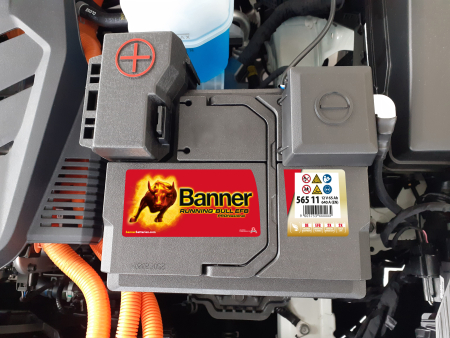E-MOBILITY
WHEN AND HOW IS THE 12V BATTERY CHARGED IN A HYBRID CAR?
A mechanic recently had this to say on the subject:
No PHEV car model (PHEV Plug-in Hybrid Electric Vehicle) has an alternator (generator) installed, which usually charges the battery while driving.

After some thorough research, here's our answer.
The 12V starter and on-board electrical system battery is always charged while driving, whether via the combustion engine or the electric motor, through the kinetic energy recovered during deceleration and braking phases (= energy recovery). Furthermore, the starter and on-board electrical system battery is also charged when the PHEV is plugged into a charging station. Depending on the car manufacturer, the 12 V starter and on-board battery is always charged during the charging process of the high-voltage battery - i.e. regardless of the state of charge (SOC State Of Charge) - or only when the high-voltage battery is charged to approx. 80%.
The charging current always comes from the high-voltage battery (Li-ion) via a DC/DC converter (direct current converter). This is always in operation in every driving mode.
PS: In general, DC/DC converters are used wherever lower, higher or negative voltages are required, such as in vehicles (cars PHEV plug-in hybrid), photovoltaic systems, industrial trucks, various drive systems and many other applications.
Banner lexicon / e-mobility ABC
Plug-in hybrid cars (PHEV plug-in hybrid electric vehicle)
Hybrid vehicles (HEV hybrid electric vehicle) generally use one or two electric motors always in combination with an internal combustion engine. In HEV car models, the drive battery and the starter or on-board electrical system battery are charged via the combustion engine and the recovered braking energy (energy recovery). During braking, the electric motor becomes an alternator (generator) and feeds the kinetic energy back into the high-voltage battery – thus charging the drive battery together with the starter and on-board electrical system battery.
In contrast to this, the batteries of PHEV cars are also charged with a plug via the electricity grid and are capable of covering shorter distances (usually around 30-50 km) completely electrically, as well as comfortably covering longer distances using the combustion engine.
This is why they are classified – as e-cars, even if a conventional drive is combined with the electric one.

Well-known PHEV car models on the road include:
+ Audi A6 and Q5
+ BMW X1 to X5
+ VW Golf and Passat GTE
+ Seat Leon and Tarraco
+ Lexus 450RS
+ Mitsubishi Outlander and
+ Toyota Prius
to name just a few of the better-known ones.
A brief note on wording to avoid any confusion over terminology.
The on-board electrical system battery is also known colloquially as an auxiliary, backup, support, additional or second battery.
The lithium-iondrive battery is also referred to as a high-voltage battery (HV = high voltage).
The abbreviation DC stands for „Direct Current“.
More articles on this subject

